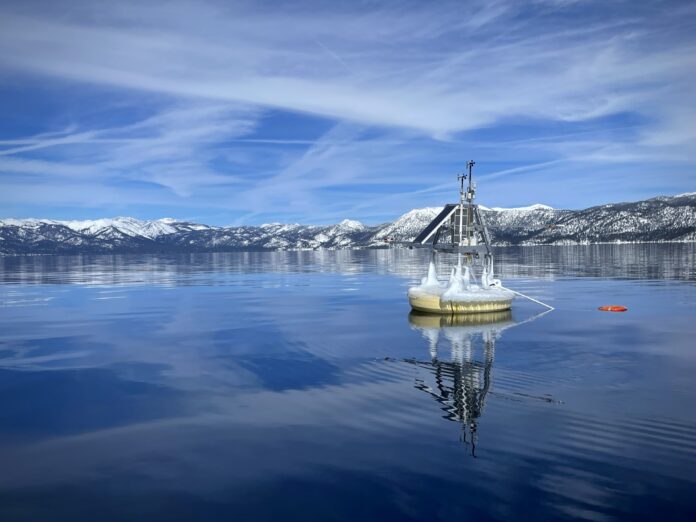Lake water clarity is expected to continue improving as long as zooplankton populations remain high
By LILLY ACKERMAN — science@theaggie.org
From August to December of 2022, Lake Tahoe’s clarity was the best it has been since the 1980s, according to the 2022 annual clarity report from the UC Davis Tahoe Environmental Research Center (TERC). Lake clarity averaged 80.6 feet during these five months, starkly clearer than the approximately 70-foot average seen over the last 20 years.
The TERC monitors several aspects of Lake Tahoe, including its aquatic ecology, physics, atmospherics and even nearby forestry. Notably, researchers with the TERC have been measuring water clarity since the late 1960s.
Clarity measurements are taken using a tool called a Secchi disk; the one used by the TERC is a white disk with a 10-inch diameter that is lowered into the water until it disappears from view. The depth at which it disappears is averaged with the depth at which it reappears upon being pulled back up to give an accurate clarity depth reading.
Several factors can negatively influence Lake Tahoe’s clarity, including land disturbance, fires and the amount of snowpack each year, as these factors affect the amount of sediment and other fine particles added to the water. However, the recent increase in clarity seems to be tied to the lake’s aquatic ecology.
According to Geoffrey Schladow, a professor in UC Davis’s Department of Civil and Environmental Engineering and the TERC’s founding director, a shrimp species called Mysis was introduced to the lake in the 1960s with the intention of feeding game fish so that they would become larger and more abundant.
Unfortunately, the shrimp began feeding excessively on the lake’s native zooplankton, the microscopic animals that live in the water — notably the species Daphnia and Bosmina, instead.
“What wasn’t realized is that the Daphnia and Bosmina are very efficient grazers,” Schladow said. “So the way they eat is they literally just shovel everything in a certain size range into their mouths. The net effect of their feeding was to gather up all these tiny particles that impact lake clarity and just remove them from the water.”
Naturally, the rampant consumption of these zooplankton by Mysis shrimp since the 1960s has removed a lot of the zooplankton’s filter-feeding power and has had a long-term effect on water clarity that has only very recently been considered.
According to Brant Allen, a field lab director and boat captain at the TERC, it wasn’t until 2002 that researchers began to think zooplankton might have substantial impacts on water clarity. This came after a brief decrease in Mysis shrimp and a resurgence of Daphnia.
“With the resurgence of the Daphnia, we saw a dramatic increase in water clarity that we really couldn’t attribute to anything else,” Allen said. “So it has given us this new view that the aquatic ecology of the lake and restoring the native zooplankton could have a serious impact on water clarity in a positive way.”
According to the researchers, a reduction in Mysis in late 2021 allowed for blooms in Daphnia and Bosmina zooplankton populations, contributing to the recently observed increase in lake clarity.
Due to the life cycle and history of Mysis in Lake Tahoe, researchers at the TERC believe that clarity will continue improving throughout 2023. However, they emphasize that Mysis will likely return within the next few years and lower zooplankton abundance once again.
“The restoration target for Lake Tahoe is to get the average annual clarity to be about 97 feet,” Schladow said. “I think by the end of this year, we would be very close to that target of 97 feet, but it’s not going to last, so it’s a great learning opportunity.”
Knowing what has strong effects on Lake Tahoe’s water clarity can inform future management decisions about maintaining zooplankton populations and minimizing swells of Mysis numbers. For now, we can appreciate Lake Tahoe’s increase in clarity while being mindful of what has caused it and why it may not last.
“[We will see if] we can actually track that decrease in water clarity with the resurgence of the shrimp and the loss of the zooplankton,” Allen said. “And if we do, that’s really powerful information for being able to say that the zooplankton have a strong correlation to good water clarity.”
Written by: Lilly Ackerman — science@theaggie.org





